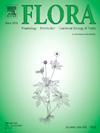Heat-resistance response of Ceiba aesculifolia seedlings induced by thermopriming
IF 1.8
4区 生物学
Q3 ECOLOGY
引用次数: 0
Abstract
Ceiba aesculifolia (ceiba) is a tropical plant species with high resistance to environmental stresses and assigns biomass and reserves to belowground tissues to cope with hydric stress. We determined if thermotolerance can be induced in ceiba seedlings by implementing a heat stress and heat priming protocol to germinating seeds. Assessment of seedling survival and development was done at two developmental stages, fully expanded cotyledon and three true leaves seedlings under controlled conditions, as well as saplings under field conditions. Heat stress was induced by subjecting germinated seeds to different supra-optimal temperatures for 45 min. A 100 % of seedlings subjected to heat below 42 °C survived. Seedling survival decreased at 48 °C and 50 °C, the latter also accumulated starch as a result of the treatment. The priming temperature was set at 37 °C since germinating seeds did not present any injury in the radicle and all seedlings survived. Thermopriming treatment at 37 °C for 90 min promoted 50 % of seedling survival to the lethal temperature (51 °C) and an increase in starch accumulation. No significant change on plant height and coverage in field conditions were detected in thermo-primed plants. Seedling survival and further development at 51 °C after thermopriming indicates the induction of thermotolerance mechanisms in ceiba by the presence of two or three tubers in 50 % of the treated seedlings and a 27 % increase in tuber starch content. These early developmental / functional responses in ceiba could allow them to develop and establish in heat-stressed soil environments.
热蒸煮对木棉幼苗耐热性的影响
Ceiba aescullifolia (Ceiba)是一种热带植物,对环境胁迫具有很高的抗性,并将生物量和储量分配给地下组织以应对水分胁迫。我们通过对发芽种子实施热胁迫和热诱导来确定是否可以诱导木棉幼苗耐热性。在两个发育阶段,对照条件下的全子叶和三真叶幼苗和田间条件下的树苗进行了幼苗存活和发育评价。将发芽种子置于不同超适温度下45 min,诱导热应激。在低于42°C的温度下,100%的幼苗存活。在48°C和50°C处理下,幼苗成活率下降,后者也积累了淀粉。萌发种子胚根无损伤,幼苗全部成活,因此将萌发温度设置为37℃。37°C热浸处理90 min可使50%的幼苗在致死温度(51°C)下存活并增加淀粉积累。在田间条件下,热处理植株的株高和盖度变化不显著。在51°C高温处理后,木棉的幼苗存活和进一步发育表明,50%的处理幼苗中存在两个或三个块茎,块茎淀粉含量增加27%,从而诱导了木棉的耐热机制。这些早期发育/功能反应可以使木棉在热胁迫土壤环境中发育和建立。
本文章由计算机程序翻译,如有差异,请以英文原文为准。
求助全文
约1分钟内获得全文
求助全文
来源期刊

Flora
生物-植物科学
CiteScore
3.30
自引率
10.50%
发文量
130
审稿时长
54 days
期刊介绍:
FLORA publishes original contributions and review articles on plant structure (morphology and anatomy), plant distribution (incl. phylogeography) and plant functional ecology (ecophysiology, population ecology and population genetics, organismic interactions, community ecology, ecosystem ecology). Manuscripts (both original and review articles) on a single topic can be compiled in Special Issues, for which suggestions are welcome.
FLORA, the scientific botanical journal with the longest uninterrupted publication sequence (since 1818), considers manuscripts in the above areas which appeal a broad scientific and international readership. Manuscripts focused on floristics and vegetation science will only be considered if they exceed the pure descriptive approach and have relevance for interpreting plant morphology, distribution or ecology. Manuscripts whose content is restricted to purely systematic and nomenclature matters, to geobotanical aspects of only local interest, to pure applications in agri-, horti- or silviculture and pharmacology, and experimental studies dealing exclusively with investigations at the cellular and subcellular level will not be accepted. Manuscripts dealing with comparative and evolutionary aspects of morphology, anatomy and development are welcome.
 求助内容:
求助内容: 应助结果提醒方式:
应助结果提醒方式:


